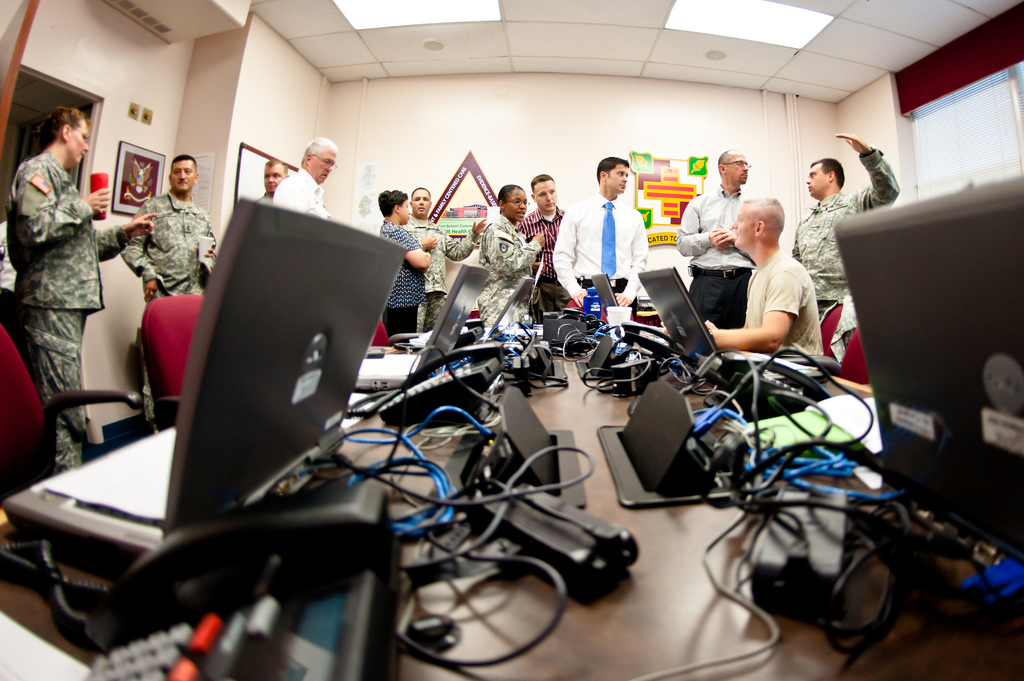

Topic Objective
Current Department of Defense force protection capabilities require the physical handling of Common Access Cards (CAC) and other DoD-issued identification cards. This process results in the physical handling of cards which are known vectors of diseases and which can result in large percentages of personnel being exposed. This is issue is specifically pertinent to bases and installations such as the Pentagon, military bases, and highly secured special facilities. Pandemic Entry & Automated Control Environment (PEACE) utilizes the metadata already collected and stored on CAC cards and related databases to facilitate rapid and seamless entry capability with the additional utility of providing both entry as well as internal control of personnel distribution and activities. In time, this capability could further be leveraged to promote network security as well as control of weapons and their platforms under respective programs of record.
Description
Current identity management requires having a physical card (something you have) which is subject to compromise and in a pandemic environment results in a significant risk to the population that is to be protected. PEACE leverages biometric (something you are) and other metadata (something you know, i.e. password) already collected, so that entry operations to bases and installations can be conducted safely and the military’s mission successfully accomplished. Use of PEACE provides real-time validation of persons at the entry point location as well as within the installation and various facilities.
Phase I
Provide a white paper outlining a strategy towards gaining this capability that leverages current CAC card metadata (including biometrics) and other respective metadata. To the extent possible, the approach should comply with open standards and leverage existing infrastructure to include sensors currently employed for entry operations. The goal should be to increase throughput of personnel at entry points by order of magnitude over existing procedures while increasing safety and security. It is permissible to leverage other electronic systems commonly carried by military and governmental personnel. However, such leverage should not affect standard entry during degraded operations (i.e. failure of electrical system, cellular network, etc.).
Phase II
Successfully demonstrate the system’s capabilities at an entry point as well as within the base/facility on a military installation.
Phase III
The objective is a flexible system of identification that is not reliant on something one is carrying and that provides a comparable or superior level of protection while providing scalable, reliable and smarter DoD force protection capabilities. This capability will be used across DoD and governmental agencies and would apply for commercial and general public use without compromising any aspect of the privacy or security of the process or participating individuals. Objective capabilities would be used to secure access to sensitive/classified areas, access and operations of critical weapons/respective platforms, and homeland protection in urban areas. Commercial applications include venues such as Disney World where annual passes are sold as well as major sporting events whose tickets are subject to counterfeiting.
Submission Information
To submit full proposal packages, and for more information, visit the DSIP Portal.

References:
Topic Objective
Current Department of Defense force protection capabilities require the physical handling of Common Access Cards (CAC) and other DoD-issued identification cards. This process results in the physical handling of cards which are known vectors of diseases and which can result in large percentages of personnel being exposed. This is issue is specifically pertinent to bases and installations such as the Pentagon, military bases, and highly secured special facilities. Pandemic Entry & Automated Control Environment (PEACE) utilizes the metadata already collected and stored on CAC cards and related databases to facilitate rapid and seamless entry capability with the additional utility of providing both entry as well as internal control of personnel distribution and activities. In time, this capability could further be leveraged to promote network security as well as control of weapons and their platforms under respective programs of record.
Description
Current identity management requires having a physical card (something you have) which is subject to compromise and in a pandemic environment results in a significant risk to the population that is to be protected. PEACE leverages biometric (something you are) and other metadata (something you know, i.e. password) already collected, so that entry operations to bases and installations can be conducted safely and the military’s mission successfully accomplished. Use of PEACE provides real-time validation of persons at the entry point location as well as within the installation and various facilities.
Phase I
Provide a white paper outlining a strategy towards gaining this capability that leverages current CAC card metadata (including biometrics) and other respective metadata. To the extent possible, the approach should comply with open standards and leverage existing infrastructure to include sensors currently employed for entry operations. The goal should be to increase throughput of personnel at entry points by order of magnitude over existing procedures while increasing safety and security. It is permissible to leverage other electronic systems commonly carried by military and governmental personnel. However, such leverage should not affect standard entry during degraded operations (i.e. failure of electrical system, cellular network, etc.).
Phase II
Successfully demonstrate the system’s capabilities at an entry point as well as within the base/facility on a military installation.
Phase III
The objective is a flexible system of identification that is not reliant on something one is carrying and that provides a comparable or superior level of protection while providing scalable, reliable and smarter DoD force protection capabilities. This capability will be used across DoD and governmental agencies and would apply for commercial and general public use without compromising any aspect of the privacy or security of the process or participating individuals. Objective capabilities would be used to secure access to sensitive/classified areas, access and operations of critical weapons/respective platforms, and homeland protection in urban areas. Commercial applications include venues such as Disney World where annual passes are sold as well as major sporting events whose tickets are subject to counterfeiting.
Submission Information
To submit full proposal packages, and for more information, visit the DSIP Portal.
References:
